Userpilot vs Product Fruits: Which is Better for User Analysis?
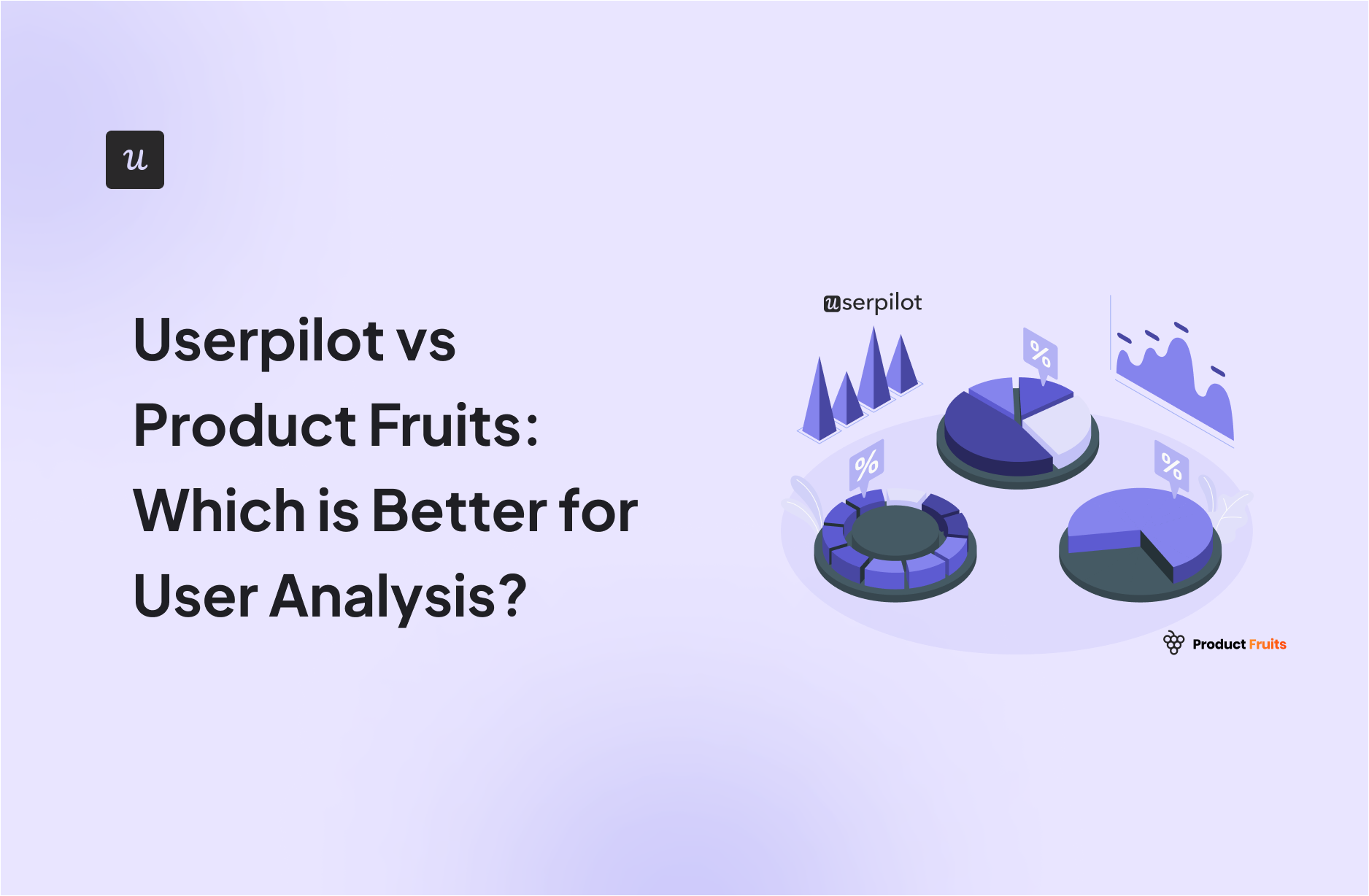
Is Userpilot or Product Fruits the best tool for user analytics? And is there a better software that would better fit your needs?
With so many alternatives on review sites, it’s a bit tricky to really choose one.
You need to consider your priorities and what functionality you’ll need from the tool to get the job done. Then there’s also the price that needs to match your budget. Right?
In this post, we’ll discuss exactly that – what the perfect tool for performing user analysis should deliver and which will be the best choice for your company’s needs.
Let’s dive in!
TL;DR
- Let’s explore how Userpilot and Product Fruits compare when it comes to performing user analysis.
- Userpilot is a product growth platform that drives user activation, feature adoption, and expansion revenue. It also helps product teams collect user feedback, streamline onboarding, and gather actionable insights from analytics.
- Product Fruits is a platform designed to help you tackle issues related to software adoption. With a focus on seamless customer onboarding, this tool allows companies to create engaging in-app journeys.
- While both Userpilot and Product Fruits offer commendable user experience and engagement, Userpilot tends to shine a bit brighter in several key areas. Here’s why:
- A/B testing: Data-driven decisions, customer engagement, and conversion rate optimization are all outcomes of effective A/B testing. While Product Fruits leverages Google Optimize for its A/B testing, Userpilot integrates this functionality directly within the app. This approach not only simplifies the process but also enhances accessibility.
- Tailored checklists and knowledge base: Userpilot allows users to create customized checklists and knowledge bases. These can be tailored to different customer segments and stages in the customer journey. This offers a depth of personalization that Product Fruits lacks.
- Advanced Segmentation: Userpilot allows you to build multi-language flows using its AI-powered translation service, and there’s no limit on the number of users you can segment. It allows for more effective feedback collection through trigger surveys tied to user journey milestones and NPS surveys for measuring product sentiment. You can also track how users are behaving within the app and group them accordingly. So, if someone hasn’t completed their onboarding, you can send a personalized in-app message to help them along. While Product Fruits provides basic user-specific segmentation, it lacks the comprehensive and contextual capabilities of Userpilot.
- Integrations: Both Product Fruits and Userpilot offer 9 integrations. Although, they do share some common integrations like Intercom, Mixpanel, and HubSpot. However, the integration of Slack and Userpilot is currently under development. Most integrated products within the same category carry out similar tasks, no matter what specific tool you opt for. For example, Userpilot has an in-app integrated product analytics tool, unlike Product Fruits. This tool boasts features similar to those found in other tools, like graph and funnel creation, and more.
- Advanced analytics: In the realm of analytics, Userpilot truly stands out. You’ll be able to deeply understand user behavior and sentiment, without fussing over coding or API calls. Your selected features can be tagged for precise tracking, no dev team is required. Curious about user actions like button clicks or purchases? Userpilot’s heatmap offers insight into your users’ most and least interacted areas. Unlike Product Fruits, Userpilot lets you monitor your checklists’ effectiveness live, transforming raw data into actionable insights.
- Get a Userpilot demo and drive your product growth code-free.
What is user analysis?
User analytics is the process of capturing and analyzing user behavior within your product. This helps to understand how different segments act in-app, identify friction and drop-off points, and make data-driven decisions.
Must have features for user analytics tools
Choosing the right user analytics tool is important for understanding your customers’ behavior and optimizing their journey. Here’s what you should look for:
- Event tracking: The chosen tool should come with the ability to set up events for monitoring in-app behavior. It should be capable of tracking both client and server-side events so you can have a better understanding of how users interact with your product.
- Analytics dashboards: These include no-code reports and dashboards that you can easily build to draw meaningful insights from collected data. It’s also highly recommended that these dashboards have advanced segmentation filters so you can filter data for a better understanding of specific user groups.
- Surveys: In addition to behavioral data, it’s also necessary that the chosen tool is capable of collecting and analyzing feedback. Such direct data from customers can help you understand customer expectations and work on improving your product.
Userpilot for user analytics
User analytics lets you track and analyze the behavior of users within your product. Userpilot lets you filter through customers from a unified dashboard, extract insights from specific segments or time periods, and create custom segments for all users who meet certain conditions. Here’s an overview of Userpilot’s analytics features:
- Users dashboard: Userpilot’s users dashboard gives you an overview of all user data in one place. You’ll be able to filter by segments, which companies users are from, or when they were last seen active. You can also export data in bulk as a CSV or perform actions on individual users.
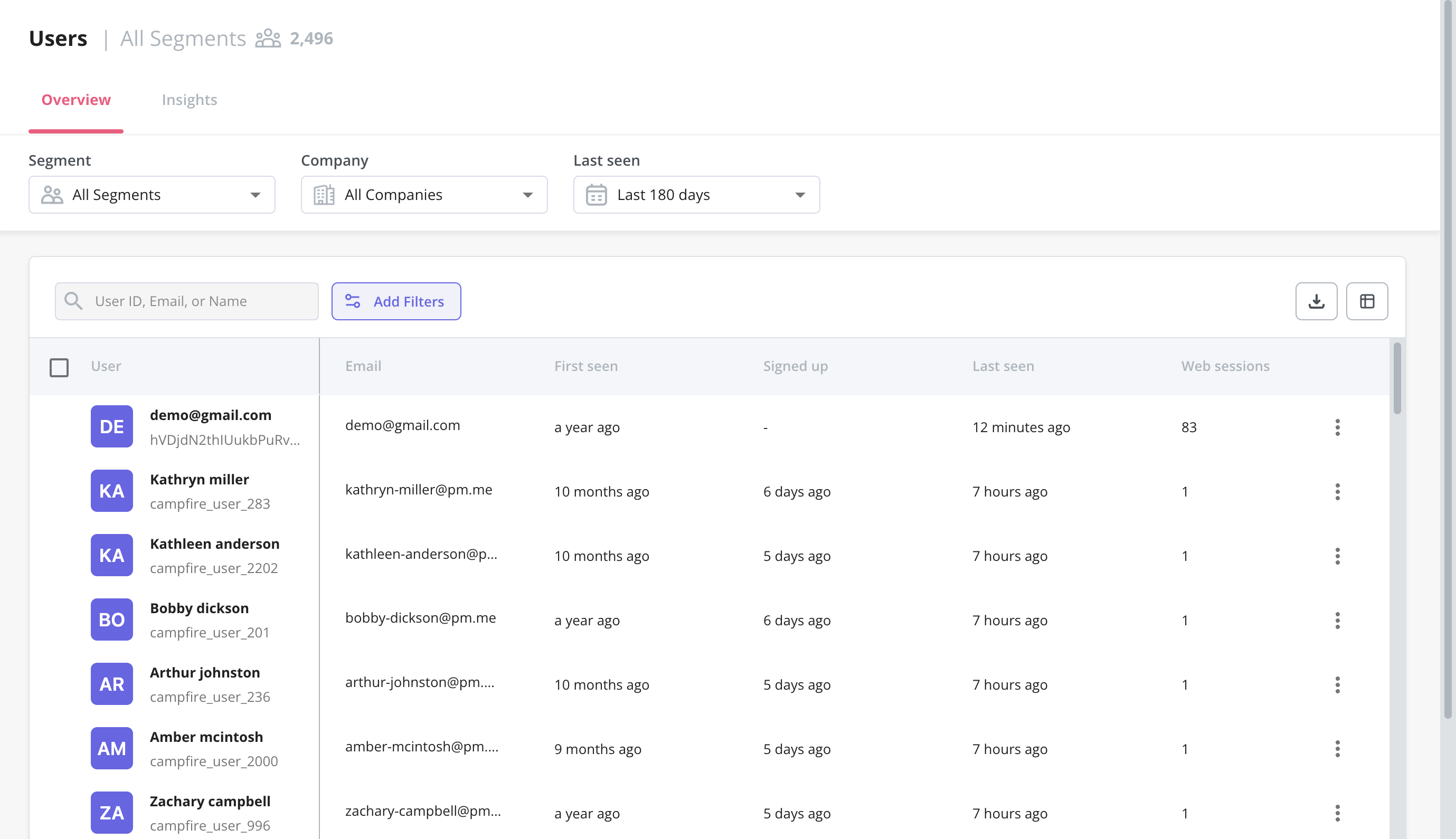
- User and company profiles: Here, you can view data related to a certain user/company to gain insights into their behavior i.e. Top events, Top pages, Sessions, Sentiment – user’s feedback (NPS & Survey), etc. With such granular insights, you can go one step further with your personalization efforts.

User profile with top event data.
- Audience insights: Much like the overview dashboard, the Insights section lets you filter metrics by segment, company, and time period. You’ll be able to choose between a daily, weekly, or monthly view and then compare data between the current and previous time periods.
- Conditional segmentation: Practical use cases for user analytics include creating segments for all users that meet certain conditions. For instance, you could reach out to companies in a certain country when creating a new flow or target customers who have tried certain features.

- Saved reports: With Userpilot, you can create funnels, trends, retention tables, and path reports. The saved reports dashboard lets you view, edit, duplicate, or delete any trend and funnel reports you’ve created. You’ll also be able to sort by report type, filter by the teammate who created the report, or export in bulk if you need a CSV of your user analytics.
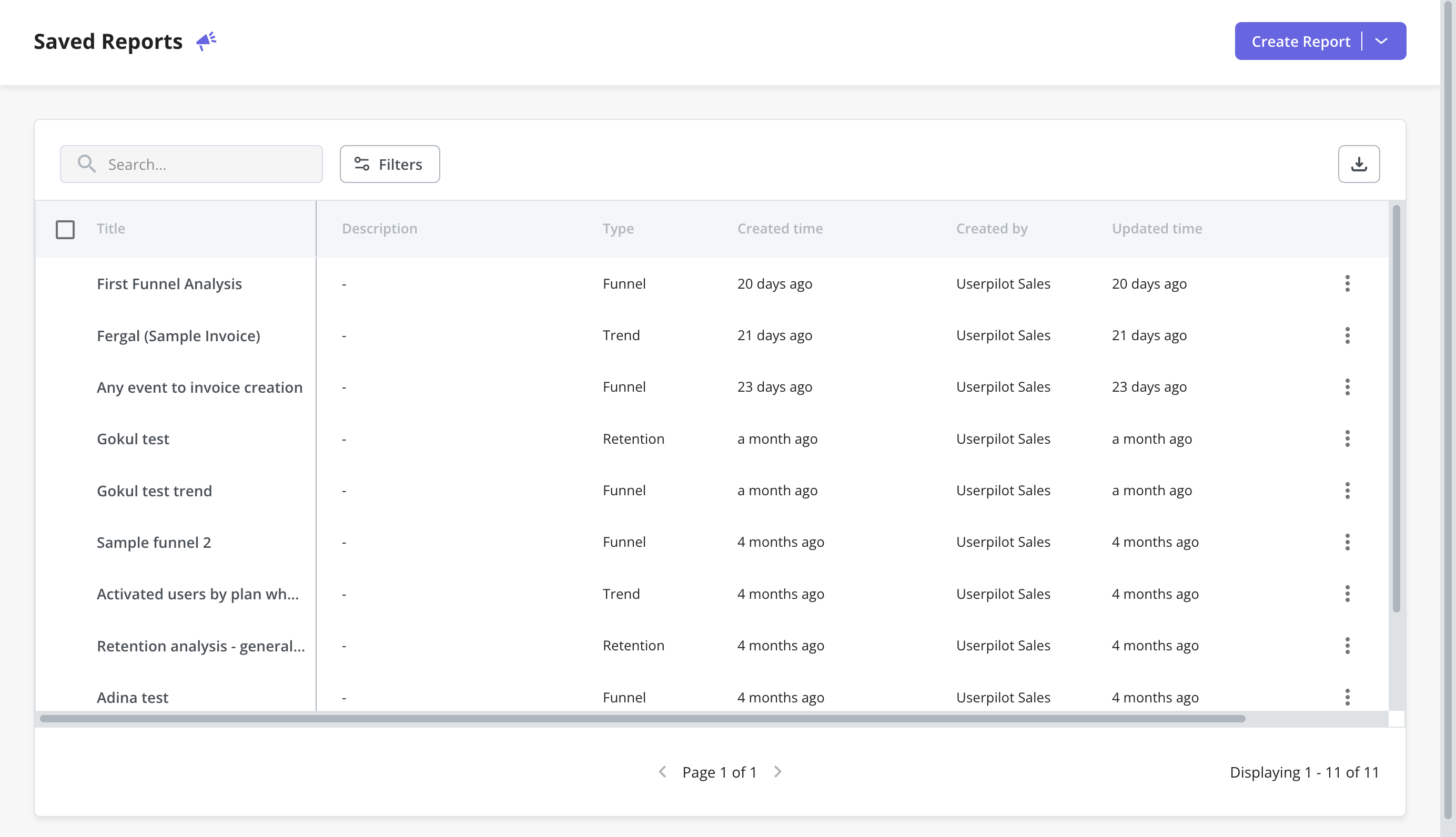
- Dashboards: Once you log in to Userpilot, you will see a collection of dashboards that collects all your key product metrics like product usage, user activation, feature engagement, etc. These dashboards are automatically available without you having to set anything up.
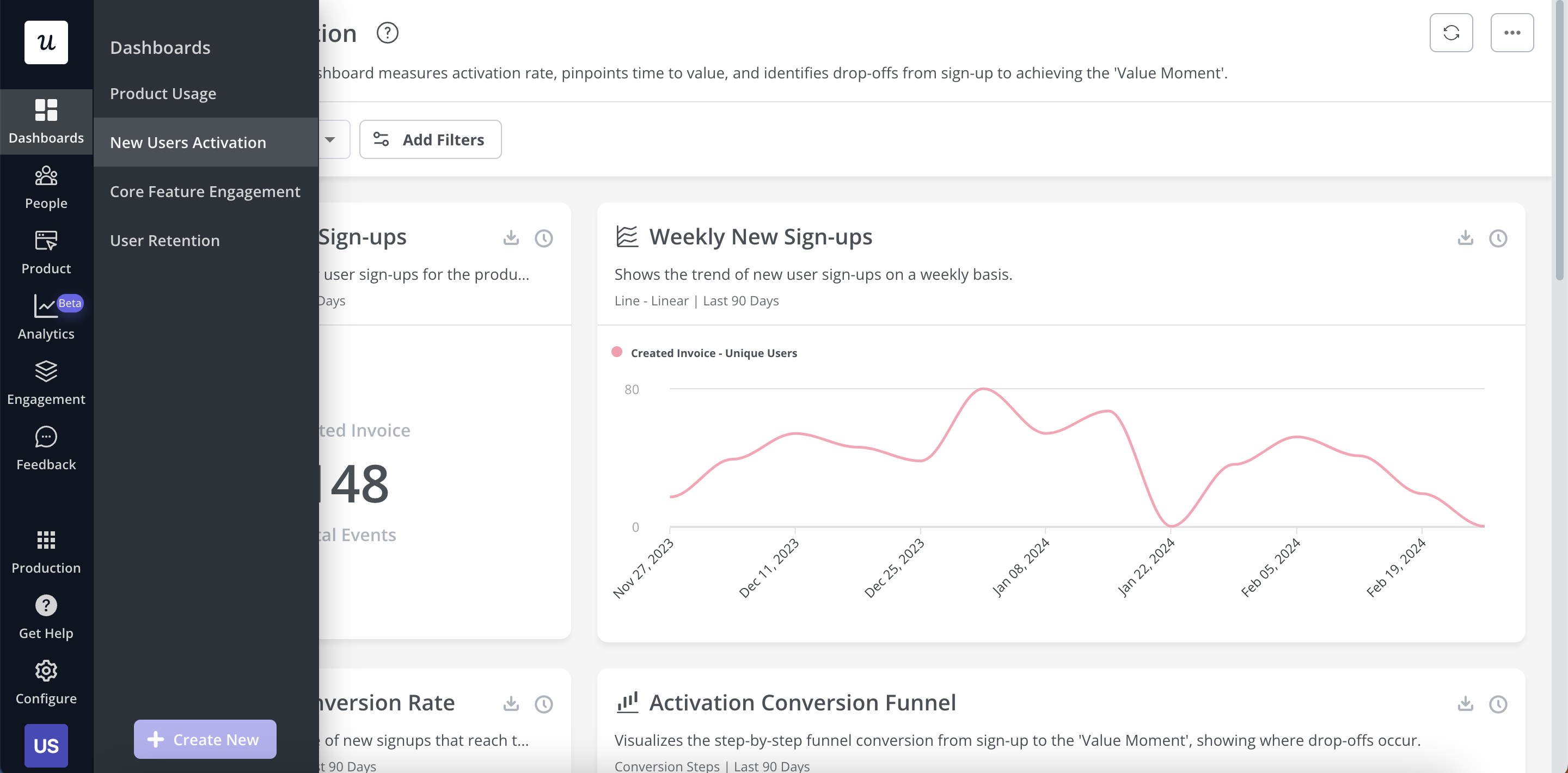
Types of analytics dashboards available in Userpilot currently.
In-app events in Userpilot
Tracking and analyzing event data gives you a better understanding of user behavior so you can capitalize on opportunities to improve the in-app experience.
Here are the ways you can use Userpilot as an event-tracking tool:
- Event tracking: The Userpilot flow builder lets you track custom events by tagging individual features (Feature Tag), by API (called Tracked Events) or by setting them up using a combination of feature tags and tracked events (Custom Events).

- Feature tags: Userpilot’s no-code feature tagger lets you track important features/elements based on different interaction types (clicks, hovers, and text inputs). You can then display the engagement and performance of different features through heatmaps.
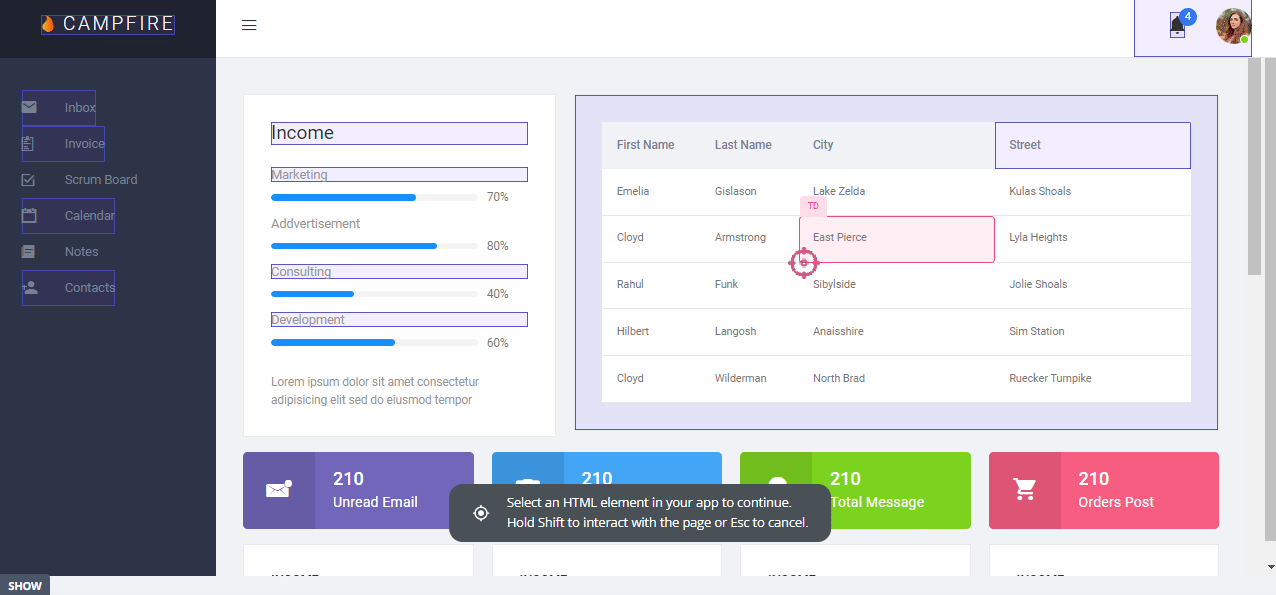
- Data integrations: Userpilot has native integrations with popular analytics tools like Amplitude, Mixpanel, Google Analytics, and more. This makes it possible to sync your event data across multiple tools within your tech stack.

In-app surveys in Userpilot
In-app surveys are an effective way to collect direct feedback from users without being at the whim of their email inboxes. Userpilot’s built-in functionality lets you create surveys, translate them, and track granular survey analytics that offer additional user insights.
Here are the Userpilot features you can use when building in-app surveys:
- Survey templates: Userpilot’s no-code survey builder has 14 templates to choose from. These include NPS, CSAT, and CES surveys among others for collecting quantitative and qualitative feedback from users. You can add a series of questions to gather valuable insights.

- Survey translation: Userpilot’s AI localization feature lets you translate surveys in a matter of minutes. All you need to do is add the desired locale and leave the rest to Userpilot. You can also make manual tweaks to translations if needed.
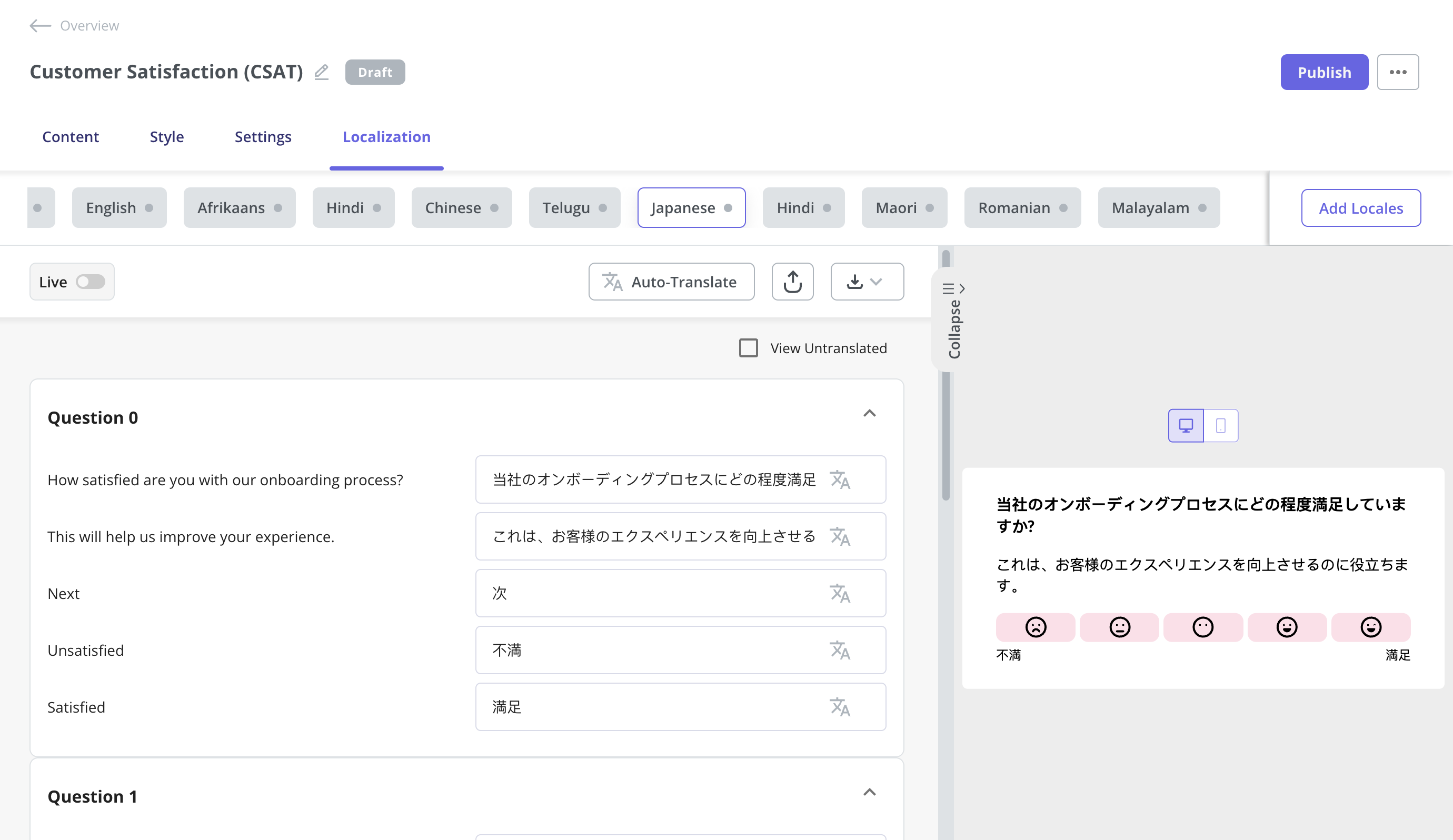
- Advanced analytics: Userpilot has detailed analytics that shows what percentage of users chose a specific option, summarizes the most popular choices, and lets you browse through open-ended responses to extract insights from qualitative feedback.

Product Fruits for user analytics
User analytics tools are a game changer when it comes to accelerating your product’s growth. They give you a clear view of your users’ actions within your product and the reasons behind them. But if you’re after top-notch user analytics, Product Fruits might not be your first choice.
That being said, Product Fruits does bring some basic user analytics to the table:
- User Behavior Tracking: This tool gives you a sneak peek into how your users navigate your product. Although it doesn’t dive as deep as some heavy-duty analytics tools, it still offers valuable insights.
- Performance Metrics: Want a snapshot of your onboarding success? Product Fruits dishes out the basics – completion rates, time spent, etc.
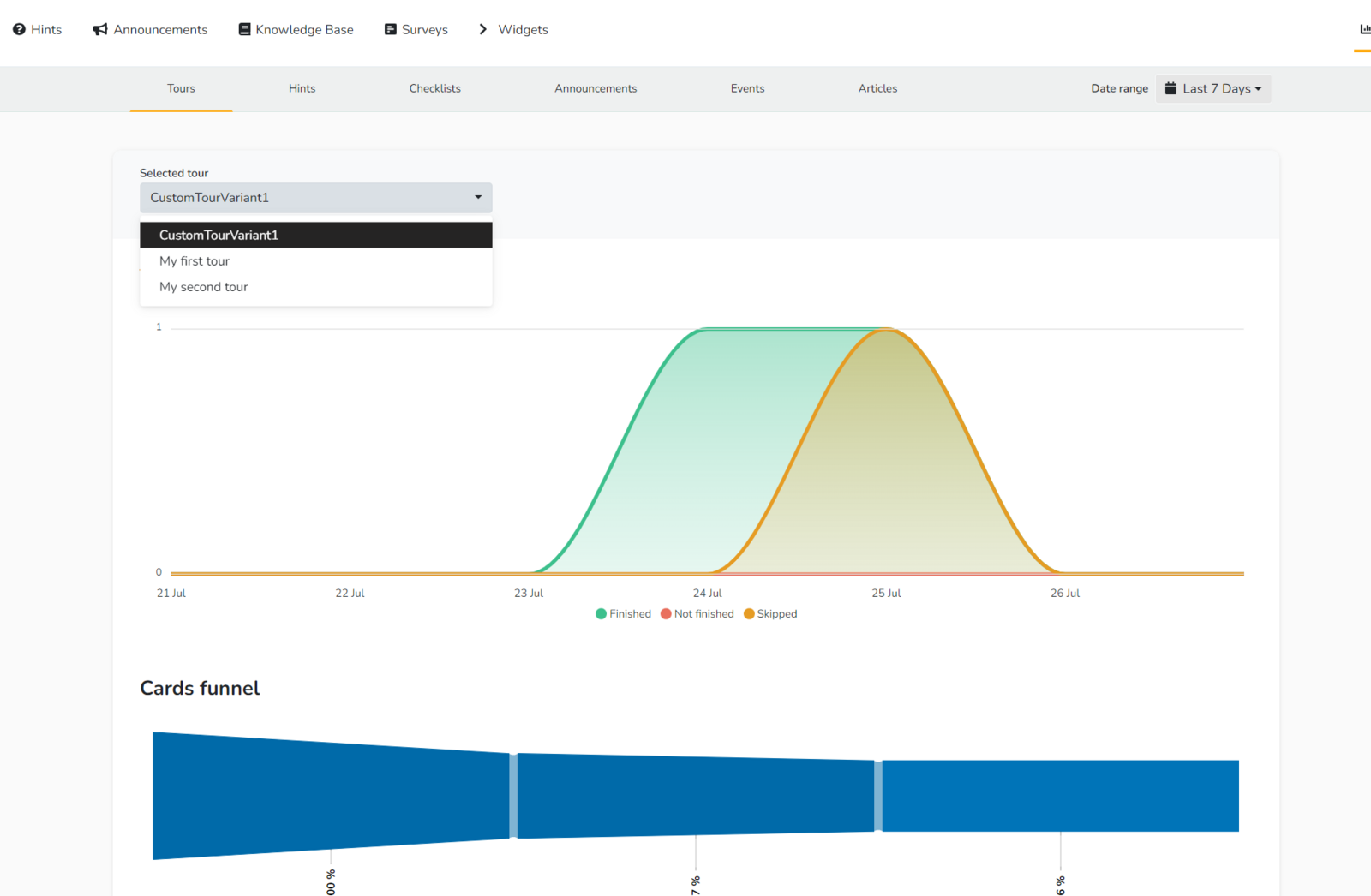
- A/B testing: Boost user engagement, reduce bounce rates, and increase conversion rates effectively with A/B testing. For A/B testing Product Fruits tours or hints, Google Optimize is your go-to tool. Unlike Userpilot, it doesn’t offer in-app A/B testing.
If advanced user analytics is your game, check out Userpilot. This tool goes the extra mile, offering in-depth user segmentation, goal tracking, and A/B testing. The insights it provides could make a difference in understanding user behavior and fine-tuning your onboarding process.
In-app events in Product Fruits
Setting up and tracking custom events is integral to understanding user behavior and improving product adoption. Analyzing event data can offer in-depth insight into how users navigate your app and engage with different features. That, in turn, can help you build more effective onboarding flows and improve user experience.
Like any standard product adoption platform, Product Fruits lets you set up custom events. Here’s how you can track events with it:
- You can use the Events Tracking feature offered by Product Fruits to track events. You’ll have to first create a custom events group and set up events for actions like clicks, hovers, and form-fills. The best part here is that you have a WYSIWYG editor so you can set up events by clicking on individual on-page elements. You can also use the Editor to add multiple events to the same group. This feature comes in handy for building conversion funnels.
- Once you’ve created a set of events, you can open the corresponding event group in your Product Fruits workspace to monitor user activity over a week. You can also activate or deactivate an event group for tracking.

- Product Fruits also provides more detailed insights into event activity data, and you can filter the results by date range to identify changes in user behavior.

It’s worth noting that, unlike Userpilot, Product Fruits only offers custom event tracking in higher-tier plans. Also, the element detection algorithm is wobbly, and the UX of the Events Tracking page malfunctions occasionally. For instance, if you leave the page open for too long, you might have to refresh it before you’re able to launch the Editor.
In-app surveys in Product Fruits
Understanding user sentiment and identifying their pain points is indispensable to improving retention and reducing churn. And that’s where in-app surveys step into the picture.
Unlike email-based ones, in-app surveys usually ensure better response rates. They come in handy when you want to understand whether your marketing and product development initiatives are headed in the right direction. Additionally, they help you understand users better and devise more effective product growth strategies.
When it comes to implementing in-app surveys, Product Fruits offers a few different options. These include NPS surveys, CSAT surveys, welcome surveys, and churn surveys. However, the selection of survey templates isn’t as vast as other platforms like Userpilot. In-app surveys are only available for higher pricing tiers on Product Fruits.
Here’s what you get for in-app surveys on Product Fruits:
- Product Fruits offers survey templates for CSAT, NPS, Product Rating, Welcome, and Churn surveys. You also have the option to start from scratch and you get small and large survey options for these.
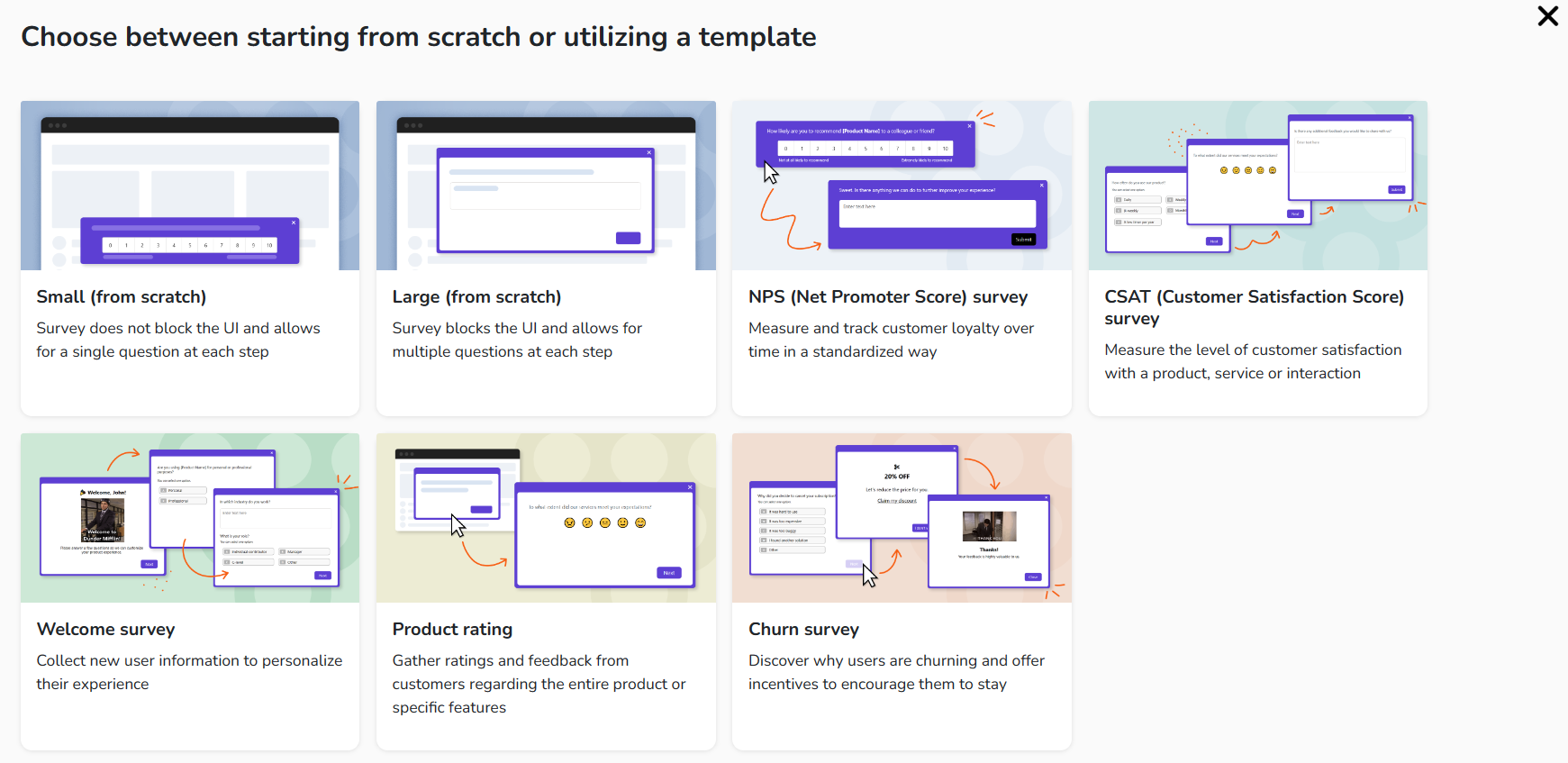
- Depending on the selected template, you can customize various aspects of the survey, including the text, visual appearance, triggers, and audience targeting. You also get a “Branching editor” to edit the flow of survey questions based on previous answers.
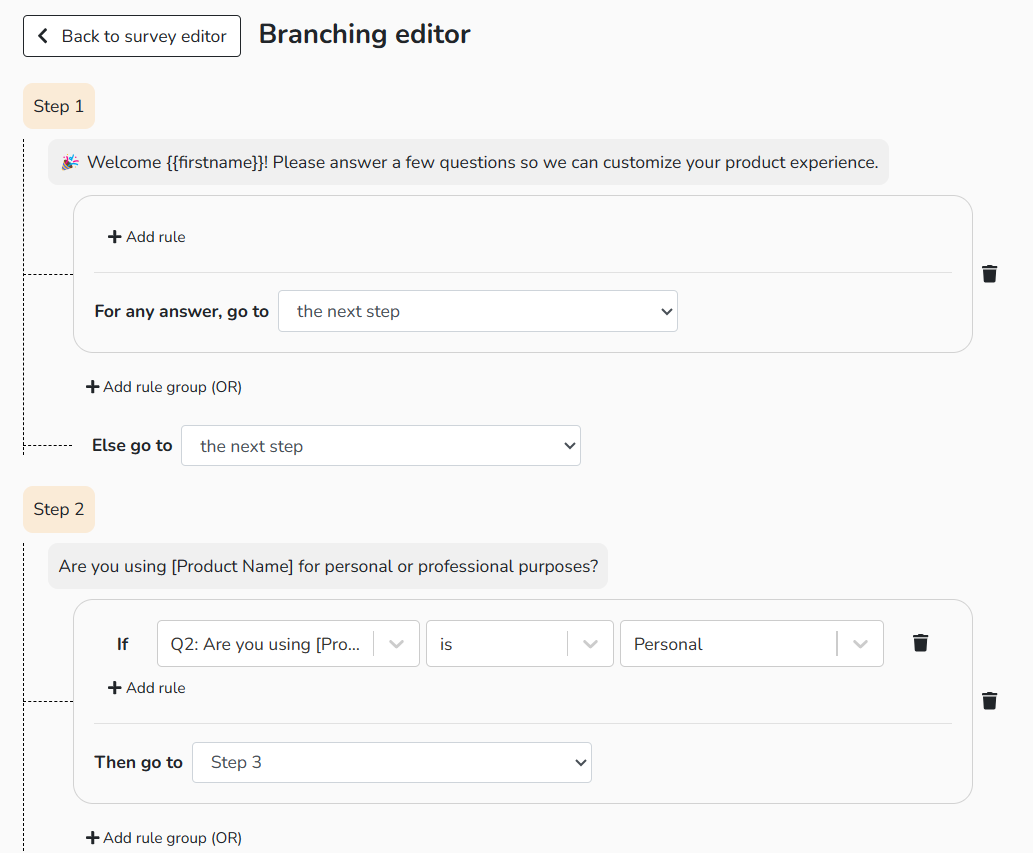
- Once you’ve published a survey, you can view the responses right away. You can check individual user responses and aggregated answers to questions. Also, you have the option to filter the results by date range and export them to an Excel sheet.

- However, Product Fruits lacks built-in functionalities to let you analyze qualitative feedback and use them to trigger personalized in-app experiences. If you’re looking for such advanced survey analytics and targeting, Userpilot might be a better option.
Pros and cons of Userpilot
While Userpilot’s versatile feature set and relatively affordable entry-level plan make it an attractive option for most SaaS companies, there are bound to be certain scenarios where it simply isn’t the right tool for the job.
Here are a few scenarios where you should look for a different tool other than Userpilot:
- Tight budgets: Userpilot is the best option for mid-market SaaS companies who want to get the most bang for their buck with plans including unlimited feature usage, fully interactive walkthroughs, advanced analytics, integrations, and a wide array of feedback collection mechanisms — all starting at $249/month. However, early-stage startups with sub-$100 budgets may want to look into options like Intercom, UserGuiding, and Product Fruits.
- Employee onboarding: Userpilot’s Chrome extension and no-code flow builder only works with your product, meaning it can’t be used to onboard employees to third-party apps. For onboarding internal teams, WalkMe is a viable solution that you should consider.
- Mobile apps: Userpilot is only compatible with responsive web apps as a narrow focus is essential to providing the best functionality needed to onboard users. As such, those looking to onboard users to mobile apps should check out platforms like Appcues and Pendo.
Pros of Userpilot
As a full-suite digital adoption platform, Userpilot has all the features you need to onboard users, track analytics, and gather feedback from customers without writing a single line of code. Here are a few pros of using Userpilot as your product growth solution:
- No-code builder: Userpilot’s Chrome extension lets you build flows, add UI elements, and tag features without writing a single line of code.
- UI patterns: There are plenty of UI patterns to choose from when using Userpilot, such as hotspots, tooltips, banners, slideouts, modals, and more!
- Startup-friendly: Userpilot’s entry-level plan gives you access to all available UI patterns so you can hit the ground running.
- Walkthroughs and flows: Build engaging interactive walkthroughs and personalized onboarding flows that target specific segments of your user base.
- Self-service support: Build an in-app resource center to help users solve problems, customize its appearance to align it with your brand, and insert various types of content (videos, flows, or chatbots) to keep your customers satisfied.
- A/B testing: Userpilot’s built-in A/B testing capabilities will help you split-test flows, iterate on the best-performing variants, and continually optimize based on user behavior.
- Feedback collection: Userpilot has built-in NPS surveys with its own unified analytics dashboard and response tagging to help you retarget users. There are other survey types to choose from and you can even create your own custom survey.
- Survey templates: There are 14 survey templates to choose from so you can gather feedback on specific features or run customer satisfaction benchmarking surveys like CSAT and CES.
- Advanced analytics: Userpilot lets you analyze product usage data, monitor engagement on all in-app flows, and use the data to create user segments that are based on behaviors instead of demographics.
- Event tracking: Userpilot’s no-code event tracking lets you tag UI interactions (hovers, clicks, or form fills) and group them into a custom event that reflects feature usage.
- Third-party integrations: Userpilot has built-in integrations with tools like Amplitude, Mixpanel, Kissmetrics, Segment, Heap, HubSpot, Intercom, Google Analytics, and Google Tag Manager so you can share data between all the solutions in your tech stack.
Cons of Userpilot
Of course, no tool is perfect and there are a few cons to consider before choosing Userpilot as your user onboarding or product growth solution:
- Employee onboarding: Currently, Userpilot only supports in-app customer onboarding.
- Mobile apps: Userpilot doesn’t have any mobile compatibility which could make it difficult for developers with cross-platform applications to create a consistent user experience for both versions of their product.
- Freemium plan: There’s no freemium Userpilot plan so those bootstrapping their startup and need sub-$100 solutions should consider more affordable onboarding platforms like UserGuiding or Product Fruits.
Pros and cons of Product Fruits
Let’s explore typical situations where Product Fruits may not meet your user onboarding requirements, and it would be beneficial to consider an alternative:
- You need advanced segmentation and personalization: Despite Product Fruits providing basic user segmentation, it falls short when compared to alternatives like Userpilot, which offers comprehensive, contextual capabilities. Userpilot enables multi-language flows with its AI-driven translation service and has no user segmentation limits. It promotes effective feedback collection through milestone trigger surveys and NPS surveys for gauging product sentiment. If a user is struggling with onboarding, Userpilot sends personalized in-app messages to aid them.
- You want advanced analytics: Userpilot outshines Product Fruits with its analytics prowess. It helps deeply comprehend user behavior and sentiment without coding or API hassles. Userpilot tags your chosen features for accurate tracking and employs a heatmap to visualize your users’ activity patterns. Additionally, Userpilot provides live monitoring of your checklists, turning raw data into practical insights.
- You need more survey templates and better survey analytics: Userpilot surpasses Product Fruits by offering more survey templates for user experience improvement, product research, customer satisfaction, and sales attribution. The analytics feature allows for filtering by segment, company, and timeframe, delivering metrics tailored to your requirements. Userpilot also provides a series of numerical charts to give a comprehensive overview of your survey’s performance. This includes total views, completion rate, and average completion time.
Pros of Product Fruits
Product Fruits offers many benefits with its easy-to-use, no-code platform. It is one of the good solutions for companies looking for affordable user onboarding, product adoption, and product analytics.
So, what does Product Fruits bring to the table? Let’s explore its promising pros:
- Guided Product Tours: It guides users to learn about your app through step-by-step tours for new features.
- Newsfeed: Enhance your users’ connectivity by sharing updates about your product. Additionally, you can set specific newsfeed items which will be displayed in the knowledge base.
- Feedback Through Screenshots and Videos: This feature allows users to send screenshots or videos directly within the app to provide feedback.
- Tooltips: These are brief hints added to different parts of the application to guide users and prevent confusion
- Life Ring Button: A comprehensive support hub that combines all guidance and support resources in one location. This allows users to conveniently access onboarding flows, support documents, and tutorials, no matter what page they’re on.
- Custom Events: Trigger actions based on what users do in your app for more personal interaction.
- Segmentation: Create unique experiences for different types of users and show tailored content to separate user groups.
- Analytics: Gain valuable insights into user behavior, identify improvement areas, and address pain points effectively.
- AI Writer: This feature instantly generates your onboarding copy. However, it is only available in higher-tier plans.
Cons of Product Fruits
While Product Fruits does have its merits, it’s not without its share of issues. Let’s see some potential drawbacks that might have you considering alternatives.
- Absence of A/B Testing: Product Fruits lacks A/B testing, a vital feature for refining your product tours based on user responses and data-backed insights.
- Basic Analytics: Product Fruits does not offer in-depth analytics as its competitors like Userpilot. This makes it difficult to evaluate user interaction and the success of your onboarding
- Insufficient Segmentation Options: The segmentation options here are only based on user attributes. This means you can’t highlight particular app functions or experiences based on a user’s past actions in your app, which can limit the customization of their experience.
- Missing Event-Based Triggering: The absence of real-time triggers may limit timely content delivery. This could affect the success of all in-app flows, such as product tours, tooltips, walkthroughs, modals, etc.
- Complex Tour Configuration: Configuring tours with specific conditions, especially when tuning CSS selectors, can be challenging and time-consuming.
- Limited Integrations: This tool links up with analytic tools, which is great. However, it doesn’t go beyond that. You won’t be able to bring in your resource center materials or link up your CRM unless you’re a Hubspot user.
Userpilot vs Product Fruits: Which one fits your budget?
Understanding the cost implications is paramount when selecting the right solution for user analysis, so here’s a detailed pricing comparison of Userpilot and Product Fruits.
Pricing of Userpilot
Userpilot’s transparent pricing ranges from $249/month on the entry-level end to an Enterprise tier for larger companies.
Furthermore, Userpilot’s entry-level plan includes access to all UI patterns and should include everything that most mid-market SaaS businesses need to get started.

Userpilot has three paid plans to choose from:
- Starter: The entry-level Starter plan starts at $249/month and includes features like segmentation, product analytics, reporting, user engagement, NPS feedback, and customization.
- Growth: The Growth plan starts at $749/month and includes features like resource centers, advanced event-based triggers, unlimited feature tagging, AI-powered content localization, EU hosting options, and a dedicated customer success manager.
- Enterprise: The Enterprise plan uses custom pricing and includes all the features from Starter + Growth plus custom roles/permissions, access to premium integrations, priority support, custom contract, SLA, SAML SSO, activity logs, security audit, and compliance (SOC 2/GDPR).
Pricing of Product Fruits
The platform offers two distinct plans. Each of these plans is tailored to accommodate the number of users you have. Here’s a detailed breakdown of each plan:
- Core: $89/month for 1,500 users. This package includes features like tours & walkthroughs, a knowledge base, and basic integrations. Notably, the onboarding checklist is limited to three items, and there’s also a Life Ring Button for support and announcements feature.
- Boost: $149/month for 1,500 users. This package contains everything in the Core plan, with added benefits such as custom event triggers, advanced integrations, and an AI writer. It also includes features like NPS & Surveys, and access management, ensuring a smoother user experience.
- Enterprise: This plan is custom-priced according to your needs. It’s meant for larger organizations requiring features like SAML SSO, custom terms & conditions, SLA, and bespoke features and integrations.
Core plan is reasonably priced but may not provide the depth of features that a growing company might require. Hence, the Boost plan offers more comprehensive user onboarding and engagement tools. The customizable Enterprise plan is a more appropriate choice for organizations with specific requirements.
You can easily subscribe to any pricing plan without a credit card. Plus, there’s a 14-day free trial on offer. Opting for the yearly plan can be cost-effective, saving $20 on any plan.
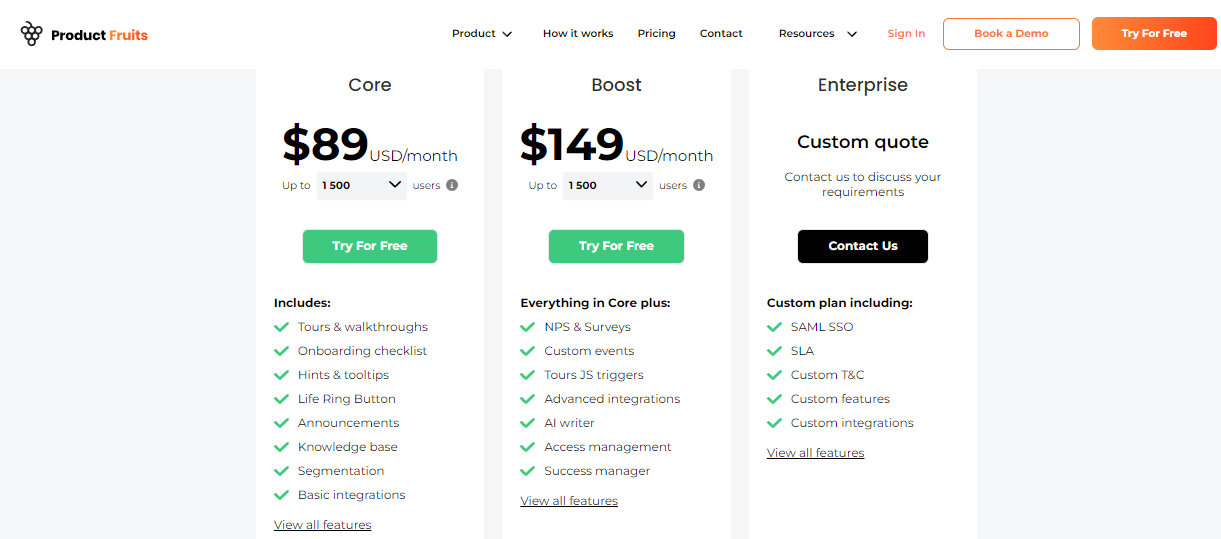
Userpilot vs Product Fruits – Why Userpilot might be a better choice?
While both Userpilot and Product Fruits offer commendable user experience and engagement, Userpilot tends to shine a bit brighter in several key areas. Here’s why:
- A/B testing: Data-driven decisions, customer engagement, and conversion rate optimization are all outcomes of effective A/B testing. While Product Fruits leverages Google Optimize for its A/B testing, Userpilot integrates this functionality directly within the app. This approach not only simplifies the process but also enhances accessibility.
- Tailored checklists and knowledge base: Userpilot allows users to create customized checklists and knowledge bases. These can be tailored to different customer segments and stages in the customer journey. This offers a depth of personalization that Product Fruits lacks.
- Advanced Segmentation: Userpilot allows you to build multi-language flows using its AI-powered translation service, and there’s no limit on the number of users you can segment. It allows for more effective feedback collection through trigger surveys tied to user journey milestones, and NPS surveys for measuring product sentiment. You can also track how users are behaving within the app and group them accordingly. So, if someone hasn’t completed their onboarding, you can send a personalized in-app message to help them along. While Product Fruits provides basic user-specific segmentation, it lacks the comprehensive and contextual capabilities of Userpilot.
- Integrations: Both Product Fruits and Userpilot offer 9 integrations. Although, they do share some common integrations like Intercom, Mixpanel, and HubSpot. However, the integration of Slack and Userpilot is currently under development. Most integrated products within the same category carry out similar tasks, no matter what specific tool you opt for. For example, Userpilot has an in-app integrated product analytics tool, unlike Product Fruits. This tool boasts features similar to those found in other tools, like graph and funnel creation, and more.
- Advanced analytics: In the realm of analytics, Userpilot truly stands out. You’ll be able to deeply understand user behavior and sentiment, without fussing over coding or API calls. Your selected features can be tagged for precise tracking, no dev team is required. Curious about user actions like button clicks or purchases? Userpilot’s heatmap offers insight into your users’ most and least interacted areas. Unlike Product Fruits, Userpilot lets you monitor your checklists’ effectiveness live, transforming raw data into actionable insights.
What do users say about Userpilot?
Most users laud Userpilot for its versatile feature set, ease of use, and responsive support team:
I recently had the pleasure of using Userpilot, and I must say it exceeded all my expectations. As a product manager, I’m always on the lookout for tools that can enhance user onboarding and improve overall user experience. Userpilot not only delivered on these fronts but also went above and beyond with its impressive new features, unparalleled ease of use, and truly exceptional customer support.
What truly sets Userpilot apart is its outstanding customer support. Throughout my journey with Userpilot, the support team has been responsive, knowledgeable, and genuinely dedicated to helping me succeed. Whenever I had a question or encountered an issue, their support team was always there to assist promptly, going above and beyond to ensure my concerns were addressed effectively.

Source: G2.
Of course, other users are also kind enough to share constructive criticism regarding specific features like event tracking filters:
“The filtration while analyzing specific events is a little confusing. Understanding of custom properties and data management configuration could have been more organised.”

Source: G2.
Conclusion
This is the end of our thorough comparison between Userpilot and Product Fruits. You should be able to make a confident decision by now. If you’re looking for a solid tool for user analytics that promises great value for money, give Userpilot a go. Book a demo today.



